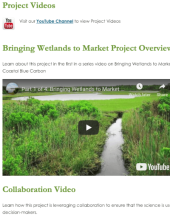
In the struggle to slow climate change, coastal wetlands are a critical asset—acre for acre, they can store up to five times as much carbon as rainforests. When wetlands are damaged or destroyed, they shift from being carbon “sinks ” to being carbon sources that release greenhouse gases into the atmosphere. Unfortunately, wetlands are disappearing at an alarming pace, and decisions to develop, protect, or restore them are often made in the context of limited public resources. Trading wetlands carbon offsets on carbon markets is an exciting new approach to creating financial incentives for restoration and conservation. To help “bring wetlands to market, ” the Waquoit Bay Reserve led a cutting-edge, collaborative research project in 2011 that examined the relationship between salt marshes, climate change, and nitrogen pollution and developed tools to leverage the “blue carbon ” stored in wetlands to achieve broader management goals.
As part of this project, the team developed a four-part video series, "Bringing Wetlands to Market: Nitrogen and Coastal Blue Carbon." The first video gives an overview of the project; the second describes the project's field research; the third discusses the tools that the project team worked to develop; the fourth explains how the project team collaborated with end users to achieve meaningful and useful tools and products.